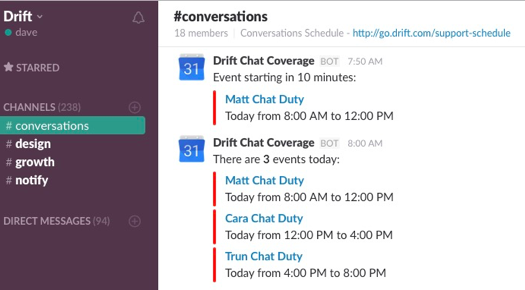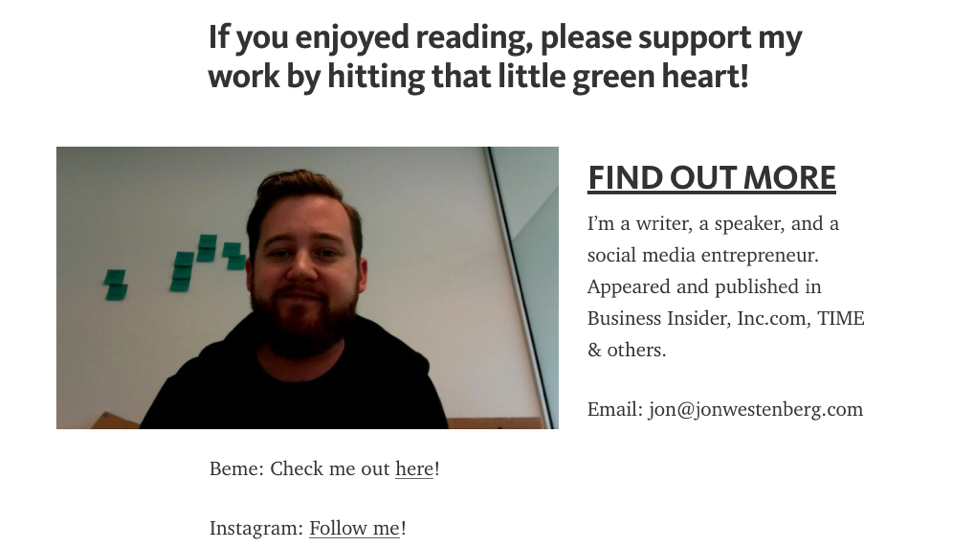
There are 15 people on our team at Drift.
Like most businesses, we all have different roles and responsibilities -- there are frontend engineers, backend engineers, designers, marketers, a product manager, a customer success manager, and a sales rep.
And while each one of our roles is very clearly defined, there are two things that we all have in common regardless of what our job descriptions say on paper: we all do sales, and we all do customer support.
The Power Of 1:1 Conversations With Prospects And Customers
This might seem counterintuitive, right? An engineer probably isn’t going to be great at sales and a marketer won’t make the best support rep. But here’s why we do it anyway:
In order to really understand what our customers want, we need to hear their pain, see their frustrations, and understand their challenges first-hand.
An internal wiki post with notes from a product manager who just spent all week talking to customers is great. But reading that feedback can’t compare to having a real-time, 1:1 conversation with someone on our website who can’t figure out our pricing. Or talking to a new customer that’s lost inside of our app -- while they’re lost inside of our app.
Getting this 1:1 feedback outweighs any lack of sales or support experience that any one of us might have.
And because this feedback is so powerful, we don’t want to relegate talking to customers to one person or one department. Talking to customers should be part of everyone’s job today.
This is especially important in today’s world. There’s a fundamental shift happening in business right now: helping is the new selling, and customer experience is the new marketing. As a result, whoever understands the customer best will be the one that wins their business and earns their money. At Drift, we call it the customer driven revolution. All of the power in business has shifted into the hands of the buyer.
Still not convinced that everyone on your team should have a sales role and a support shift? Here are three reasons why this can have a huge impact on your company’s growth.
How All Hands Sales And Support Will Help You Grow Faster
It keeps everyone close to customers. Everyone says they are customer-driven. Everyone knows the importance of talking to customers. But here’s the standard line you hear from most companies when it comes to actually doing it: “I know. I know. I need to make the time to get out there and talk to more customers. I’ve just been so busy.” This will always be the case until you make it part of everyone’s job. When you give everyone on your team a dedicated shift, this guarantees that people are spending time that week talking to customers. We set up a shared Google Calendar and the whole team gets reminders in Slack about their support shift each day to help hold everyone accountable:

Problems get solved faster. Problems. Bugs. Unclear copy. Whatever it is, it gets fixed faster when the people with the power to fix those problems are the ones talking to customers. A few months ago, we launched a new integration with Slack on Product Hunt. As a result of being on Product Hunt, hundreds of people signed up within the first few hours. But shortly after launch we kept getting the same question: “Hey, where do I connect Drift to Slack?” Even though we had a step in the onboarding flow to hook up Slack, it wasn’t obvious to most people. One of our UX designers was working her support shift during this launch, and instead of generating a support ticket, creating a new Trello card, or adding something to a future roadmap, she just grabbed one of our engineers and within two minutes, shipped a quick fix -- a link to take people directly to Slack. Giving everyone on your team a support shift will help make UX, design, product, messaging, and pricing issues painfully obvious -- and that’s a good thing.
You create real relationships with people. Putting everyone on the front lines ensures that your team is always having one to one conversations and connecting with people -- from people who are thinking about buying from you, to people who are already paying customers, to people who just wanted to write in and say that they enjoyed that blog post you wrote.
How You Can Make 1:1 Work For Your Company
Now that we’ve talked a little about the value of 1:1 conversations, here is the ultimate question: how can you make it work at your company?
There’s one question that comes up anytime someone talks about the topic of 1:1 conversations with prospects and customers, and it goes something like this:
“I like the idea. And I get the value and the power of having 1:1 conversations, but it doesn’t really scale.”
And I totally hear you.
Smaller companies or early stage startups like Drift can make 1:1 work because we need to talk to everyone at this stage. But traditionally, 1:1 conversations have been designated for support.
Sales and marketing don’t want to waste time dealing with support questions and talking to leads who aren’t qualified. That’s why marketing qualified leads (MQLs) and sales qualified leads (SQLs) were created in the first place.
But here’s the truth about 1:1 conversations with prospects and customers: this approach doesn’t require as much change as you might think. You don’t have to completely overhaul the way you do sales and marketing today or give everyone a support shift like we do at Drift. Here are a few small changes you can make right now to start having more 1:1 conversations with your prospects and customers.
Just ask. This one is the most obvious and the most effective. Sometimes, you just have to ask. One of my favorite examples of “just ask” comes from Groove CEO Alex Turnbull. In 2014, his team started to notice a spike in customer churn, and they weren’t really able to figure out why by just looking at the data. So Alex got right to the point -- he sent a personal email to every single customer and asked for 10 minutes of their time to talk. And here’s what happened:

As a result, he spent more than 100 hours talking to 500 Groove customers and ended up with feedback that helped him right the ship and fix their churn problem.
100 hours to change the course of your business? Seems worth it to me.
Now in Alex’s case, he decided to reach out to everyone at once -- and that produced hundreds of responses. If you don’t think you’ll be able to block off the time to address that many responses, then it’s easy to approach this differently. You could simply create an on-going campaign that is designed to get customer feedback one by one so you don't have to find the time to manage it in huge chunks. Sending an email blast to every customer is certainly one way to get feedback, but you can also use your customer data to create relevant segments.
And often times, talking to just 15-20 customers will give you the majority of the feedback you need (venture capitalist Jason Lemkin has something called the 20 interview rule that is similar to this). You’ll notice that after you start talking to five, six, seven customers, the same issues keep popping up. Alex chose to talk to everyone because it had been a while since he went in-depth on customer feedback.
Switch up your welcome email. While every business might not be having 1:1 conversations with prospects and customers right now, there is one thing I’m confident that everyone business does have: a welcome email. Whether it’s an email that gets triggered after someone signs up for your newsletter, requests a demo, or starts using your product, you’re probably already sending a welcome email. But there's a huge mistake that most people make with those welcome emails -- they don't send them with a purpose.
Too many people treat their welcome email as a throw away, or something that gets written at the last minute as a finishing touch to onboarding. And the reason that's a huge mistake is because your welcome email is the single most important email that you will send to your customers and subscribers.
These people are brand new. They just signed up. This is when they are the most engaged. It’s rare that you’re ever going to get this level of attention and engagement from someone again without putting in a ton of effort, so make sure to write your welcome email with a purpose.
Yes, it should be smart, funny, and welcoming – but it should also be designed to get a response. Ask new users why they signed up, what they are looking to accomplish, what they’re struggling with, or what brought them to use your product or service. This is the best opportunity you will have to strike up a conversation with a new customer or subscriber. We recently switched up our welcome email at Drift to this:

And the result has been nothing short of game changing: over the course of 12 days after making the change, we received 75 direct replies from real people telling us how they found Drift, why they signed up, and what they're working on.
But does it scale? The truth is, I can’t think of a better way to spend the first hour of every day than having conversations with real people who are interested in our business -- and that’s now how I start my day off every single morning.
Start showing your face. On our quest to automate everything we can in marketing and sales over the last five years, we've started to forget about the most important aspect of doing business in the first place: people. And because the majority of businesses operate this way, there’s a huge opportunity to stand out by showing your prospects and customers that you’re a real person. One of the easiest ways to do this is by giving everyone that comes in touch with your business a way to say hello (think of it like showing your customers that you’re always open for business) -- and putting that person’s real face out in public.
One of my favorite examples of this is what Jon Westenberg does with the articles he writes on Medium -- he shows his face and gives his email address to every single reader:

This can also be as simple as showing your face on your website’s live chat. Go to any business’ website, and there’s a good chance you’ll be able to chat with them -- but are you talking to a real person? Putting your face on live chat is one of the easiest ways to show you’re a real person -- and as a result -- start having better conversations:

You’d be surprised at how many deals you can win and customers you can delight just by saying hello, making small talk, and proving you’re a real person. It works in real life right? So why wouldn’t you take advantage of that for your business on your website.
At the end of the day, having more 1:1 conversations starts with a change in philosophy and a commitment to being more human. And from Slack to Trello to Buffer to Shopify, this is something that the best modern businesses all have in common today.
And while this change might not happen for you overnight, there are a few small changes that you can make right now to start having more conversations with your customers and people who are interested in your business.
If your company can make this work in one form or another -- even if it's only for a few hours a week manning live chat -- the impact being this close to your customers can have is one of the best things you can do for your team, regardless of what stage your company is at.
This is what we’re focused on at Drift -- helping your business have 1:1 conversations with prospects and customers at scale.
Learn more about leveraging sales and support tactics from Drift.
No comments:
Post a Comment